Are you a Quiet Speculation member?
If not, now is a perfect time to join up! Our powerful tools, breaking-news analysis, and exclusive Discord channel will make sure you stay up to date and ahead of the curve.
I'm deeply ambivalent about Modern these days. We're seeing both one of the most open fields in the format's history (Hulk Combo got T16 at an Open!), but also one of its most linear (Hulk Combo got T16 at an Open...). Whether at SCG States, the big events, or the smaller regional venues, aggressive decks shaped October's metagame, even if those decks weren't always individually the most-played strategies in Modern. This puts players in an awkward position where they have almost two dozen tier 1 and tier 2 decks to choose between, but where most of those options are soft to a broad segment of linear strategies. As someone who loved the deck and archetype diversity in June 2015, I can't say I'm too excited to see all the Burn, Affinity, combo, and Zoo hybrids rampaging across top tables.
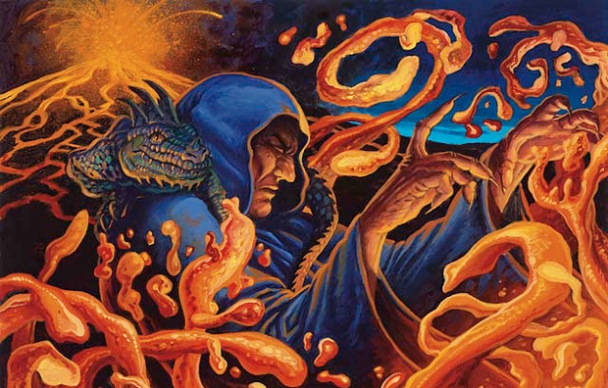
Grand Prix Porto Alegre and SCG's Dallas Open were a fitting capstone to October, showcasing not only Modern's diversity, but also its trend towards linear decks. Today's metagame update reflects all the events from 10/1 through 10/31, and although there is plenty to celebrate, the update also exhibits the same linear forces which defined GP Porto Alegre and SCG Dallas. To get a better understanding of this evolving format, we'll unpack October's tier 1 and tier 2 decks, as well as check in on predictions I made in last month's article.
[wp_ad_camp_1]
Tier 1 Decks
It's rare that any month has major events (even if they fell at the very end of the month), a tournament circuit like SCG States, and many smaller events interspersed between. October was that rare month, which means we have a lot of data to sift through and a lot of forces shaping the metagame. I already analyzed the SCG States results last week, and my findings there were only a preview of what is to come today. States is a small subset of the overall Modern world, so it shouldn't be too surprising that today's analysis looks different than what we saw at the SCG scene in mid-October.
This month, I've adjusted our Top Decks formulas to account for a dramatically reduced sample size and data quality from MTGO. Earlier this year, at the height of MTGO attendance, we averaged about 1,100 decks per month from January through July. In October, we were at a measly 210. Our margins of error for MTGO metagame shares are larger than almost all the actual shares themselves! With events averaging 6-7 players at 4-0/3-1, we can no longer rely on MTGO data as a metagame indicator. That said, we also don't want to totally ignore the data. To account for this, I've applied an adjustment based on the relative number of decks between this month and MTGO's high-attendance period. In essence, I'll be weighing the MTGO shares at only 30% of their actuals and putting proportionately more emphasis on the paper and Day 2 numbers.
The table below shows tier 1 decks from 10/1 through 10/31, incorporating results from the recent Open and GP. As always, tier 1 represents decks you are all but guaranteed to face over a long tournament. You are also likely to enjoy success with these decks. The "MTGO" column reports the observed deck shares in the time period, whereas the "Overall Metagame" column includes the MTGO adjustments.
TWIN RETURNS!! If you've been paying attention to recent metagame updates, you'll have noticed Twin's gradual decline since July, and I'm thrilled Twin pilots finally reversed their fortunes. October's tier 1 also sees Amulet Bloom rejoining the upper echelons, a testament both to its own strength and the general power of linear strategies in this Modern. Here's another table showing the tier 1 changes over the past few months.
I liked the metagame breakdown format I used in the SCG States article (more bullet points, fewer paragraphs), and I'm going to use it again this week. Let me know in the comments if it's better or worse than the more long-form writing style we've seen in previous metagame analyses.
- The Linear Decks: Affinity, Burn, RG Tron, Merfolk, Infect, and Amulet Bloom
Between these six decks, we're looking at about 37% of the format and a whopping 68% of tier 1. With tier 1 decks making up about 55% of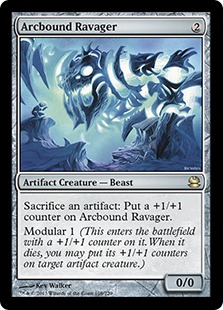 the format in this update, that's an unusual degree of linearity in both Modern's best decks and the format more generally. To some extent, Modern has always been characterized by these aggressive, linear strategies, but we haven't seen quite this many since February, following PT Fate Reforged. We also haven't seen so many linear decks increase their individual shares in a single update: with the exception of Affinity, every single linear deck increased its prevalence from September to October. It's telling that the collective increase among non-Affinity linear decks, +2.4%, actually exceeds Affinity's own decrease of -1.7%. Some of the +2.4% undoubtedly originates among Affinity pilots who swapped decks to beat the hate. The rest? Those players are coming from far and wide to switch into the linear role: everyone wants to the aggressor in today's Modern.
the format in this update, that's an unusual degree of linearity in both Modern's best decks and the format more generally. To some extent, Modern has always been characterized by these aggressive, linear strategies, but we haven't seen quite this many since February, following PT Fate Reforged. We also haven't seen so many linear decks increase their individual shares in a single update: with the exception of Affinity, every single linear deck increased its prevalence from September to October. It's telling that the collective increase among non-Affinity linear decks, +2.4%, actually exceeds Affinity's own decrease of -1.7%. Some of the +2.4% undoubtedly originates among Affinity pilots who swapped decks to beat the hate. The rest? Those players are coming from far and wide to switch into the linear role: everyone wants to the aggressor in today's Modern.
- We're seeing these performances at both the metagame-wide and tournament level.
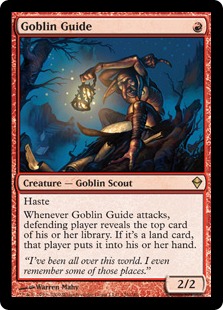 Linear decks dominated at GP Porto Alegre and SCG Dallas, although there were enough other midrange and control successes to suggest the format isn't all Goblin Guide swings. This has huge implications going into November. Looking at the six biggest linear players, it's hard to find hate cards that effectively address all their attack angles while still leaving you room for other matchups. Between artifact hate for Affinity, life-gain for Burn, two different kinds of mana-hate for Tron and Bloom, and varied removal (spot and sweeper) for Infect and Merfolk, what are you supposed to do against other decks in Modern? Many players have complained about this before, but this is the first metagame update where the data really supports the (often hyperbolic) pessimism. Consider June, my favorite Modern period of the year, where we saw tier 1 linear decks only comprise 22% of the format and 48% of tier 1 itself. People complained about linear decks then but the data didn't support them. Their fears are more founded today.
Linear decks dominated at GP Porto Alegre and SCG Dallas, although there were enough other midrange and control successes to suggest the format isn't all Goblin Guide swings. This has huge implications going into November. Looking at the six biggest linear players, it's hard to find hate cards that effectively address all their attack angles while still leaving you room for other matchups. Between artifact hate for Affinity, life-gain for Burn, two different kinds of mana-hate for Tron and Bloom, and varied removal (spot and sweeper) for Infect and Merfolk, what are you supposed to do against other decks in Modern? Many players have complained about this before, but this is the first metagame update where the data really supports the (often hyperbolic) pessimism. Consider June, my favorite Modern period of the year, where we saw tier 1 linear decks only comprise 22% of the format and 48% of tier 1 itself. People complained about linear decks then but the data didn't support them. Their fears are more founded today.
- The linear uprising puts the metagame in a pernicious loop: if you can't beat 'em, race 'em. It's hard to play the reactive game against linear decks normally. Playing it against such a diverse range of linear decks? Might as well flip some coins. For many players, it's easier to pick a linear build and try to win fast than it is to metagame against all six. How do we get out of this, both as a playerbase and individually? We'll need to return to our roots. BGx has all the tools to combat this metagame but many players are either tired of the deck, can't afford it, or doubt its power. Same goes for the URx Twin strategies (which are excellent against the linear masses). I'll talk about this more in the next two sections, but Jund and URx Twin are where we'll see an out to this issue, if indeed an "out" is possible. We might also see an exit in decks like UW Control or Abzan Company, but the power-level might not quite be there.
- The Policeman: Jund
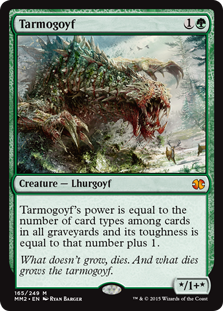 So far, I've been more measured (even uncertain) about Modern's health in this article than in previous updates. Jund, to the rescue! Ever since Modern parted ways with Deathrite Shaman, BGx decks have been a healthy and necessary policing force in Modern. That's never been truer than in October. Despite all the Bolts, Blooms, Blasts, and Become Immenses, Jund still managed to be the second most-played deck in Modern, actually increasing its metagame share from September to October. This suggests that Jund is not just alive and well in Modern, but also that Jund is thriving and ready to fill its role as format policeman.
So far, I've been more measured (even uncertain) about Modern's health in this article than in previous updates. Jund, to the rescue! Ever since Modern parted ways with Deathrite Shaman, BGx decks have been a healthy and necessary policing force in Modern. That's never been truer than in October. Despite all the Bolts, Blooms, Blasts, and Become Immenses, Jund still managed to be the second most-played deck in Modern, actually increasing its metagame share from September to October. This suggests that Jund is not just alive and well in Modern, but also that Jund is thriving and ready to fill its role as format policeman.
- Remember all those linear decks and their varied angles of attack? Jund is easily the best deck to address all of them, and one of the few strategies with access to overlapping cards for handling each deck
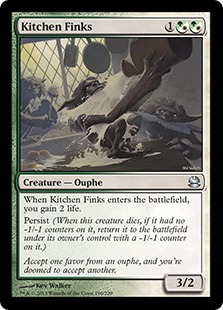 individually. In the maindeck alone, we could see Jund lists with Huntmaster of the Fells and/or Kitchen Finks, on top of the brutal removal suite of Bolt, Terminate, and Decay. Looking to the board, Jund gets artifact destruction in Ancient Grudge, lifegain in Feed the Clan, and creature hate in Night of Souls' Betrayal and Anger of the Gods. Yes, all of this might necessitate a shift away from traditional Jund powerhouses like Dark Confidant and Liliana of the Veil, or at least trimming their numbers. But that's okay! Jund is at its best when adapting to new threats, and October's metagame data already shows that in action.
individually. In the maindeck alone, we could see Jund lists with Huntmaster of the Fells and/or Kitchen Finks, on top of the brutal removal suite of Bolt, Terminate, and Decay. Looking to the board, Jund gets artifact destruction in Ancient Grudge, lifegain in Feed the Clan, and creature hate in Night of Souls' Betrayal and Anger of the Gods. Yes, all of this might necessitate a shift away from traditional Jund powerhouses like Dark Confidant and Liliana of the Veil, or at least trimming their numbers. But that's okay! Jund is at its best when adapting to new threats, and October's metagame data already shows that in action.
- Going into November, many Jund players are going to believe they don't have the tools to beat every deck in the format. This kind of despair is a trap. You don't actually need to beat every deck in the format to succeed in Modern, and it's easy to tailor Jund to beat the linear decks while preserving a 50-50 or, at worst, 45-55 matchup against fairer decks in the format. As long as Jund players continue to embrace their adaptive, policing role, we'll continue to see Jund regulating Modern. I expect to see a lot of this throughout November.
- The Prodigal Sons: UR Twin and Grixis Twin
 I've tracked Twin's decline since August, and I'm both excited and completely unsurprised to see these decks return today. With the exception of Merfolk, the linear tier 1 decks struggle in the Twin matchup, and it was about time Twin returned to exploit this. That's especially true of Affinity which remains the most-played linear deck in Modern. With BGx decks shifting to more anti-aggro options, away from the combo-busting power of Thoughtseize and the card advantage of Bob, Twin becomes even better. I never thought I'd see the day where I lamented Twin's absence, but seeing the format without Twin has changed my tune: welcome back, Deceiver Exarch overlords.
I've tracked Twin's decline since August, and I'm both excited and completely unsurprised to see these decks return today. With the exception of Merfolk, the linear tier 1 decks struggle in the Twin matchup, and it was about time Twin returned to exploit this. That's especially true of Affinity which remains the most-played linear deck in Modern. With BGx decks shifting to more anti-aggro options, away from the combo-busting power of Thoughtseize and the card advantage of Bob, Twin becomes even better. I never thought I'd see the day where I lamented Twin's absence, but seeing the format without Twin has changed my tune: welcome back, Deceiver Exarch overlords. 
- In many respects, Twin's decline wasn't quite as pronounced as I made it out to be. You were still likely to see Twin at tournaments and still likely to win events with your Twin list. That said, Twin was absolutely at historic lows in Modern, which itself had huge repercussions throughout the format. If anyone doubts the reality of this decline, I encourage you to just look at Affinity's shares in metagames since August and compare those with Twin's. Then look at today's shares and their differences. I know someone is going to hit me with the old "correlation vs. causation" argument, but this is about as clear a relationship as we can observe in a metagame. Affinity's meteoric rise would never have happened if Twin's shares hadn't been so low.
- Twin's return, especially if sustained into November, could herald a format-wide rebalancing around Twin and BGx. In turn, this would mean the decline of linear strategies that are too slow to hang with Twin and too vulnerable to roll with Jund. On the other hand, if Twin fell out of tier 1 again, it would undoubtedly lead to more linear decks prowling around the format's upper ranks: Jund can't manage Modern alone. I am optimistic Twin's return in October is a sign of things to come, but we'll need to wait until November to know for sure.
When considering the metagame numbers, it's important to place those quantitative figures in Modern's historic context. That's how we move from a set of unrelated statistics to coherent (and actionable!) narratives. Linear decks may be the most formative force in Modern's tier 1, but between Twin and Jund, the signs are pointing towards a showdown in November, a showdown that is likely to favor the Exarchs and Goyfs.
Tier 2 Decks
In some updates, the big stories are in tier 2 and it's business as usual in tier 1. That's not the case today, where the majority of format movement is happening in tier 1 and not in these lower-ranked decks. We still see some interesting changes in tier 2, but they aren't nearly as dramatic or impactful a those we saw with decks like Jund, Twin, and the linear players. This suggests the biggest takeaway from tier 2 isn't any single deck's movement, but rather the sheer range of decks in this bracket. With 12 decks represented, Modern's tier 2 is more open than usual, especially considering how many decks (an impressive nine in total) are sitting in tier 1.
The table below shows these tier 2 decks, broken out by discrete metagame percentages (and also accounting for that MTGO adjustment). As a reminder, tier 2 decks won't necessarily show up at every tournament, but you'll still need to know how to play against them. You can also bring a tier 2 deck to an event with a reasonable chance of success, although you might have better luck with a tier 1 build depending on your matchups.
Comparing this table to September's tier 2 listing, we see a lot of familiar faces and a few jumps up to and down from tier 1. Both Twin decks are back in tier 1, with Abzan falling down in their place. Ad Nauseam sinks out of our tier 2 standings, replaced by the aggressive Gruul Zoo strategy and Dickmann's favorite, Temur Twin. Following from this, here are some of the most important changes within the tier.
- Fear the Zoo: Naya Company, Gruul Zoo, and Naya Hybrids
In addition to Naya Company's and Gruul Zoo's 2% shares each, we also see an untiered 2.1% share of Naya Zoo hybrids, ranging between no-Company Zoo decks and more Burn-oriented blitz builds. These aren't showing up in the tierings because the majority of their finishes are in the skewed MTGO dataset, so we'll need to allow more time to see if they can fit into the rest of the metagame. This also doesn't include the Burn decks that are running Wild Nacatl in their main 60: those are still Burn decks, even if they borrow Zoo's workhorse (workcat?). As we go into November, you need to be prepared to handle these ultra-aggressive, creature-oriented strategies. Although they don't yet have the metagame shares to hit tier 1, they are definitely pre-trending in that direction, and I wouldn't be surprised if they get there by December 1st. Pack sweepers, lifegain, and plenty of removal that kills things at parity or better.
no-Company Zoo decks and more Burn-oriented blitz builds. These aren't showing up in the tierings because the majority of their finishes are in the skewed MTGO dataset, so we'll need to allow more time to see if they can fit into the rest of the metagame. This also doesn't include the Burn decks that are running Wild Nacatl in their main 60: those are still Burn decks, even if they borrow Zoo's workhorse (workcat?). As we go into November, you need to be prepared to handle these ultra-aggressive, creature-oriented strategies. Although they don't yet have the metagame shares to hit tier 1, they are definitely pre-trending in that direction, and I wouldn't be surprised if they get there by December 1st. Pack sweepers, lifegain, and plenty of removal that kills things at parity or better.
- The Control Struggle: Scapeshift, Grixis Control, and UW Control
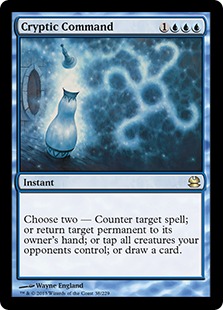 Cryptic Command is a great card in certain metagames and a wretched one in others. You know what isn't going to save you against the stream of turn 3-4 decks in Modern? A four-mana, cantripping counterspell. This is the problem decks like Scapeshift, Grixis Control, and UW Control all find themselves in, struggling to adapt to linear metagames with tools more suited to fair/midrange ones. We are already seeing Grixis mages make the shift to a more midrangey build with Liliana and Inquisition instead of the more traditional countermagic lineup. UW Control hasn't quite made the transition yet, even if Scapeshift is already experimenting with Bring to Light as a way to bring more firepower to their linear matchups. We should see these decks make changes by November, but it remains to be seen whether those changes will be enough.
Cryptic Command is a great card in certain metagames and a wretched one in others. You know what isn't going to save you against the stream of turn 3-4 decks in Modern? A four-mana, cantripping counterspell. This is the problem decks like Scapeshift, Grixis Control, and UW Control all find themselves in, struggling to adapt to linear metagames with tools more suited to fair/midrange ones. We are already seeing Grixis mages make the shift to a more midrangey build with Liliana and Inquisition instead of the more traditional countermagic lineup. UW Control hasn't quite made the transition yet, even if Scapeshift is already experimenting with Bring to Light as a way to bring more firepower to their linear matchups. We should see these decks make changes by November, but it remains to be seen whether those changes will be enough.
Most of the other tier 2 changes don't need much explanation. Abzan finds itself in the exact same position it was in back in February 2015, battling linear decks with overly-fair cards like Path and Souls. We'll see more Abzan if the metagame shifts back to fairer strategies, but until then, Jund is definitely where you want to be. As for the Company decks, especially Abzan Company, expect to see more of these as we move into November. Abzan Company is well-equipped to handle a variety of linear aggro strategies, which makes it an obvious choice in an overly aggressive format.
Modern Metagame Predictions for 11/1 - 11/30
Despite my cautious optimism, I'm really not sure what November's metagame update is going to look like. We're either going to see a shift back to a familiar BGx, Twin, and Affinity/Burn balance, or we're going to tip into a pit of linear turn 3-4 games. Pre-trends from October suggest the former is more likely, with Twin returning to the top tables and Jund weathering the aggressive onslaught, so I'm staying optimistic for now. I'm also feeling good about my metagame predictions because we've been spot-on in the past few articles. September was no exception:
- UR Twin returns to tier 1? Yes!
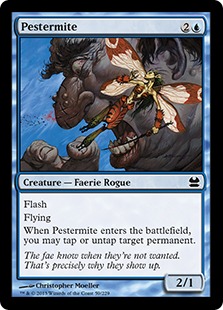 Back when I made this prediction, I couldn't imagine a Modern where players blithely allowed Affinity to enjoy an 11% metagame share while Twin floundered at 2%-4%. The community agreed and struck back with a vengeance, propelling Twin back into tier 1 off a +1.1% increase from September to October. Grixis Twin followed UR Twin's return to glory, but its own increase (+.1%) was far less meaningful than UR Twin's massive jump. Extending last months' prediction into November, both Twin decks should be able to maintain these shares through next month, with the potential for a UR Twin or Temur Twin increase depending on other factors. Grixis Twin, with a more painful manabase and inefficient removal, is unlikely to get much better in a metagame clogged with linear decks that can blast through a cute Snapcaster/Kolaghan's interaction.
Back when I made this prediction, I couldn't imagine a Modern where players blithely allowed Affinity to enjoy an 11% metagame share while Twin floundered at 2%-4%. The community agreed and struck back with a vengeance, propelling Twin back into tier 1 off a +1.1% increase from September to October. Grixis Twin followed UR Twin's return to glory, but its own increase (+.1%) was far less meaningful than UR Twin's massive jump. Extending last months' prediction into November, both Twin decks should be able to maintain these shares through next month, with the potential for a UR Twin or Temur Twin increase depending on other factors. Grixis Twin, with a more painful manabase and inefficient removal, is unlikely to get much better in a metagame clogged with linear decks that can blast through a cute Snapcaster/Kolaghan's interaction.
We're on a prediction streak and I want to keep that going as we move into the next month. At the risk of misreading metagame evolutions, I'm going to stay positive and predict a best-case scenario for November. We could also see a slide into a sea of Goblins, Nacatls, and Swiftspears, but I'm banking on a healthier outcome.
- Amulet Bloom and Infect move to tier 2. Zoo decks stay in tier 2
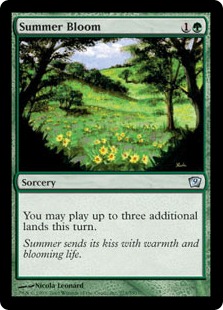 This is technically two predictions in one, but they are related enough that I'm comfortable discussing them together. The premise of this prediction is that linear decks will decline. The question is, which ones? Affinity and Burn are Modern mainstays that are unlikely to ever leave tier 1, even if their shares ebb and flow by a few percentage points from month to month. What about RG Tron? A natural Jund predator, this deck is unlikely to go anywhere, especially if BGx remains the format policeman that I hope it will. As for Merfolk, with Twin back we aren't likely to see Merfolk decline any time soon. This means the linear downshift needs to happen among the weirder, outlying decks like Amulet Bloom and Infect. Both of these decks struggle against Twin, so the Twin uptick should have the biggest impact on these two strategies. By a similar token, we shouldn't see Zoo's share drive the deck into tier 1, at least if Twin and Jund are doing their jobs.
This is technically two predictions in one, but they are related enough that I'm comfortable discussing them together. The premise of this prediction is that linear decks will decline. The question is, which ones? Affinity and Burn are Modern mainstays that are unlikely to ever leave tier 1, even if their shares ebb and flow by a few percentage points from month to month. What about RG Tron? A natural Jund predator, this deck is unlikely to go anywhere, especially if BGx remains the format policeman that I hope it will. As for Merfolk, with Twin back we aren't likely to see Merfolk decline any time soon. This means the linear downshift needs to happen among the weirder, outlying decks like Amulet Bloom and Infect. Both of these decks struggle against Twin, so the Twin uptick should have the biggest impact on these two strategies. By a similar token, we shouldn't see Zoo's share drive the deck into tier 1, at least if Twin and Jund are doing their jobs.
This was a pretty titanic metagame update, and I hope you enjoyed the mix of data and narrative in describing our format. Were there other metagame developments I missed? Any decks you want me to speak on? Bring it down to the comments and I'll see you all there!






Hi again Sheridan.
1) Grixis Control can be a great police deck as well.
I hope it has the tools along with Jund/Twin to fight all those linear decks of the format.
2) A possible Bloom ban(although it would be wrong, and I trust WotC to do the right thing in not banning Bloom) would mean less reasons to play Twin together with Merfolks always being there to fight Twin.
So, if we can agree that a Bloom or a (I dont know-Infect or somewhat ban) would be wrong -and it is for the obvious reason of cyclical meaningless random bannings through linear decks- and that it is not solving the problem but creating another one, what is right then(IF -big if here- linear decks keep dominating the format)?
The solution would be the printing of new cards in the style of Kolaghan’s Command and Abrupt Decay. Although I used to hate Abrupt Decay I get it now. These two cards are two of the best things that have ever happened lately to Modern.
I wonder : Are WoTc’s minds on the idea of fixing that in printing new cards of this style? FOR MODERN. (And not only Standard). Do we have an “inside information” about their opinions on Modern?
Hey George. Here are some thoughts on your points:
1. Trevor has a great piece coming out tomorrow about Grixis’ evolution. He’ll talk more about how players can shift the Grixis strategy to handle different Modern metagames.
2. The best solution is to print, or reprint, some generic answers midrange and control can use against the aggro and combo. Ideally, this would be countermagic: we have decent removal and discard options already. A fixed Mental Misstep would be nice. Or something Daze-like. Or a Force Spike effect that scaled a bit. This would give blue-based decks the tools they need to evolve to different metagames. Jund already has most of those. The challenge is balancing this card with Twin and Snapcaster, because we don’t want to shift the format too heavily in the opposite direction.
To make things clear: URx twin is the most played deck in modern, in case someone failed to add all the variants together.
Awesome stuff as usual.
Yessir. URx Twin is doing great right now. That’s definitely a reason we saw an Affinity downshift, although we also saw other linear decks pick up Affinity’s slack.
Great article, Sheridan. Glad to see that people are coming to their senses and the meta is balancing out (as a Merfolk player, more Twin and less Affinity is music to my ears, but I think it benefits the meta as a whole too).
One thing I am curious about, however, is what you think will be the fate of Grixis Delver. I greatly enjoy the Delver playstyle, and it’s a bit disheartening to see the foremost representative of it in Modern languishing at the back end of Tier 2. Do you think there’s an incoming correction given the rise of Twin (good Delver matchup)? Or do you think that another color combination is the key to success? I’ve tested Jeskai and Temur out as well as Grixis, and they both have their merits.
If we can restabilize after this current linear uptick, I’ll have a lot of faith in the format. We already saw rebalancing earlier this year after Abzan’s rise, and then again at the beginning of the summer with Grixis and Jund. Now we are seeing some slightly new challenges, and I’m hoping players rise to the occasion.
I honestly think the key to Delver decks is Disrupting Shoal, something Jordan has talked about for ages. This also isn’t just me plugging our authors (promise!). Delver himself is bad in Modern because of all the low-cost removal, mainly Bolt, that just blows him up before he can do anything. Shoal addresses those issues, and gives you surprise game against all-in linear decks. I’d bank on Temur because it keeps good sideboard cards while not ditching lifegain (a major drawback to Grixis).
I agree that Disrupting Shoal is probably the way to go with regards to Delver – I’ve been testing it in a couple of shells, and come away impressed.
However, I’m still undecided between Temur and Jeskai Delver, mainly because of the different spell packages involved. On the one hand, Temur offers Delver’s only palatable answer to an Abrupt Decay in Simic Charm, plus a Decay-proof threat in Hooting Mandrills. On the other hand, Jeskai has an excellent beatstick in Mantis Rider, plus better removal options thanks to Path to Exile and Lightning Helix (which gives you burn and lifegain). I’ll have to continue testing and see which one I like most, but it seems that the best way to advance the Delver cause is to move away from Grixis.
Helix is a great reason to play Jeskai in this metagame (it’s basically a 2-for-1 against all damage-based aggressive decks). Path is fine, but in tempo decks it’s not much better than Simic Charm (and Charm pitches to Shoal at the critical 2 CMC slot). Jeskai’s Rider also pitches to Shaol at 3 CMC, which is a nice luxury most Shoal decks don’t enjoy, but Rider doesn’t seem very good in this metagame. I don’t want to pay three mana for a Boltable threat in this kind of aggressive format. But I’d happily pay one mana for the delve Monkeys on turn three with some removal/countermagic backup.
Man, I love Disrupting Shoal!
well said, but i am sceptical by the fact that you characterize a large group of diverse decks as ‘linear’
for me it’s not important how often a deck chooses to interact with the opponent but how easy it is for the opponent to interact with you if he chooses to
Boggles and Storm for instance are terrible decks that promote bad magic for me, while affinity and merfolk are perfectly fine, you can interact with them however you choose and often they will interact with you with little tricks and cetain interesting lines of play both decks have, burn is something between those
also each of those deck has a vastly different effect on the meta, Tron prays on interactive fair decks, infect prays on other linear decks etc so they are not all the same and some of them do more good than harm
lastly there’s also a matter of skill intensity which is also vastly different for each of those decks, affinity for instance is a ‘deep’ deck that requires alot of experience and skill, interacting with it also requires alot of playtesting, you will be rewarded for bolting the right target and be severly punished for misplaying your removal, what’s wrong with such a deck being prevalent?
as an aggro player to show you the other side, i feel i am very limited in what i can pick:
affinity is great but can be hated too hard, burn and zoo are not good enough imo which leaves me playing mostly merfolk, which have a sweet mix of interaction and agression, i enjoy my games and find them pretty skill testing both for me and my opponents, also i am open to any form of interaction, you can interact with an piece of my gameplan you want, so what’s the problem?
for the record i was playing Jund before swtching back to my first deck( merfolks) and i found Jund to be alot more straightforward, what makes merfolk linear and Jund non-linear?
imo the word focused describes linear decks much more accurately and without the negative tone some people attempt to give it
Check out the top 8 from GP Porto Alegre for some extra on “burn and zoo are not good enough”.
I’m a Merfolk player too, but I strongly disagree with Burn and Zoo not being good enough. Burn is getting it done pretty much just as often as Merfolk is, and Zoo has carved out not one but 2 Tier 2 niches for itself (and if you combine those, it’s almost as prevalent in the meta as Merfolk). The linear decks, even with this slight adjustment, are doing fine.
All of those decks are definitely linear. They may have non-linear play trees within the decks, and they might require a lot of play skill to execute properly, but their plans are almost entirely goldfishy. Some of these decks are completely devoid of interactive cards at all. Others have some but they are incidental to a goldfishing gameplan. I also adamantly disagree that Burn/Zoo need any more help. Those decks are doing just fine.
Some players might read this article and assume linear decks are low-skill. I definitely don’t want to suggest that, and I think this article does a good job of not painting them in that way. Linear decks do, however, lead to a certain kind of warped metagame. That would be just as true if Modern were a midrange fest or a control-a-palooza. ANY kind of archetype imbalance is bad, not just linear.
I might give a little more definition to “linear” in future articles, but I’d rather reclaim the word from its negative connotations (ones, I should add, that not every player holds) than abandon it entirely.
I strongly disagree with the assertion that Burn is a linear deck. Sure there are times where it APPEARS to be but there are also many times where it is playing a control type of game. It is very evident in the Naya versions post board. It is the same with many other decks people consider to be “linear”. Affinity has SO MANY interactions and so many lines of play, how could anyone in their right mind say that it is non-interactive and linear? Elves and Infect also have some interaction, especially Game 2-3. So what decks are really just playing solitaire? Clearly Ad Nauseam, and kind of Bloom but Bloom has at least some pretty cool interactions with itself G1 and boards in some interaction G2-3.
I kind of take offense to some people in the Modern community grouping all of these decks together and essentially complaining when really there are only a handful extremely linear aggro decks and the rest are hybrids that you can’t pin down as one archetype. I just don’t get the uproar when, according to this analysis, over half of the T1 decks have what I consider interactive game play and multiple lines to victory. The same can be said about T2.
It really seems that these concerns are based off Dallas when it was pretty much a case of extreme metagame misdiagnosis and of course when that happens certain decks will just win. I think people are expecting blue decks or Jund to always win or always Top 8 and that is just not realistic in a format with at least 20 or so decks that are just really good in their own right.
Burn is as linear as it gets. Although there are many non-linear play lines in Burn, and non-linear sideboarding approaches depending on the matchup, the deck itself is fundamentally linear. That’s not a bad thing though! It doesn’t mean Burn pilots are stupid or less skilled, and it doesn’t mean the deck is bad for Modern. Many players see “linear” and immediately read into it some kind of insult or valuation. I’m just using it as a gameplan description.
Again, the emerging problem is not that “LINEAR decks are dominant in Modern”. The emerging problem is that “A SINGLE KIND OF deck is dominant in Modern”. We want a balance between control, midrange, aggro, and combo, and October saw a metagame that was heavily influenced by the latter two with comparatively less of the former. It definitely was not just Dallas/Porto Alegre; the metagame stats tracked over a hundred events and saw that trend in all of them. Those may have been the most visible events, but they weren’t the driving factors in this update.
“Solitaire” decks and “Linear” decks aren’t exactly the same. The only true solitaire deck in Modern is Ad Nauseam. Even Bloom, a deck many people view as solitaire-driven, has tons of interactive play-lines. So do Infect, Elves, Gruul Zoo, etc. But these decks are still fundamentally linear. Again, that’s not a value statement or a judgment on its players! It’s just a description of their primary gameplan.
OK so what is a non linear deck then? The only decks that IMO are TRULY non-linear are Jund and perhaps Grixis. Twin and it’s variants are basically stalling to combo out; how is that any different than what the other so called linear decks are doing? Same with Scapeshift and a bunch of other control/combo decks.
Also, how can you say this: “Burn is as linear as it gets” directly followed with a sentence describing how non-linear it is? By definition, almost all decks in Magic are going to be linear. I mean, it’s a game that seeks to get the opponent down to 0 life as fast as possible. Perhaps we should just stop using the term “linear” to describe decks in MtG because it is a terribly vague term with a negative connotation that encompasses a TON of deck types.
I see what you are saying with some of the latest trends regarding fast aggro decks but the meta will likely self police as it usually does. But at least now you can reasonably go into a tournament with 1 of 20 or so decks and have a decent shot of winning rather than having to have 1 of 5 decks to be competitive.
Also, I do agree with one of the posters above commenting on the price to entry for the format. Most new players aren’t going to drop $2k on Jund or $1.2k on Grixis/Twin. So that might also explain the rash of cheaper aggro/combo decks. I’m not sure how WotC can fix it aside from reprints and cheaper new control cards, but I’m not even convinced it needs fixing. But even though I really like playing those types of decks there’s just no way I’m spending a ridiculous amount of money on them when other good fun decks can be had for less than $500.
BTW, I really like the site and these articles even if I don’t agree with some of your opinions. Keep up the good work!
Another great metagame update.
One thing I appreciate is that your metagame predictions are ballsy. You haven’t hedged at all, setting a baseline prediction and then riding it to it’s logical conclusion. You either look like a genius or a moron, and unfortunately the internet is great at remembering the times you look like a moron. I am rooting for you though.
What I think is great about modern at the moment is just how “figured out” some of the decks are – for example, we have jund, affinity, UR twin and burn basically down to their last few slots, with a core of 54-58 cards pretty much set in stone. Compare that to some of the naya decks running around (successfully), scapeshift and grixis control builds – they are all different and nowhere near optimised. Or, if one is optimised, it is getting similar results to different versions of the same deck and being lost in the noise.
This is a perfect meta to go into a pro tour. We have the stalwart tier 1 decks that have been forged in fire over many years. Then we have the newer decks that havent been optimised.
If a team can break this format, with all the linear angles to defend against as well as finishing off the stronger disruption packed decks – good for them. They should get medals. I wouldnt even know where to start testing.
Thanks! I’ll always try and balance a realistic prediction with a gutsy one. I’ll do a year-end review in December, but I think most of the predictions have been pretty good ones so far.
My fear for the PT is that some teams will just hedge their bets on the linear decks instead of investing in the carefully-tuned police decks. If that happens, Modern will look a lot more linear than it probably is. There is real incentive to do this for pros, especially given how many events they need to prepare for. It’s often easier to just learn your own deck than it is to learn your deck on top of all the matchups you need to master. For now, I’m optimistic this won’t happen, but we’ll check back in in early December.
I think the aggro decks taking over the meta is due to the increase of new players in Modern. I’m not saying these decks are ‘easy mode’ to pilot, but they are cheaper to build and the game plan is straightforward.
Modern is more popular than ever, and looks to be taking over Legacy as the eternal format of choice for most players. SCG has acknowledged this by their recent announcement of tournament changes, which includes giving less love to Legacy.
As long as we have players getting into the format, they will go to MTG Goldfish and find a deck that is cheap to build as they learn the ins and outs of Modern. The fact that these decks are also very good is just a cock up by Wizards in overpowering red and small drops the last 5 or 6 sets. Burn is a perfect list, right now, and tough to beat even with hate. Magic never used to be like this..
Whatn ever has happened to Grixis Control? Yes, it was overly hated, but now that that has gone away, do you believe it may have a resurgence?
I have an opinion on this. Stay tuned
What do you think about the placement of Wx hatebears / taxes builds in the meta? They can main board some great answers to lots of decks and keep up with linear strategies. They can also prey on the 3 colour mana bases with leonin and ghost quarter. Vials are weak to kholaghans command but they just come out against those decks.
I’ve tested DNT and Hatebears and I think the metagame is too fair for them. Thalia and other taxing creatures get better the more degenerate the format is, and since unfair decks have overall declined since the banning of Treasure Cruise, DNT definitely isn’t an option and Hatebears is probably better going the Wilted Abzan route. DNT’s creatures are generally too small to hang with Modern’s beatsticks and are too slow compared to Zoo. Hatebears is better since its creatures are larger and it has Gavony Township but if you want to play that you should probably just spring for Wilt-Leaf Liege and just leave the hate in the sideboard.
Infect is not a linear deck
It goes linear if you tap out
But you dont want to tap out against Infect
Its close to Tempo Twin in this behavior
They will bite you every turn, but if you tap out, they will combo you
Hey Sheridan,
Your website is really taking off! It’s nice for Modern specialist like us.
Hey, do you think the metagame is really favorable for pillowfort? Maybe at least the big tournaments, it seems it will do well.
Also, it seems to me that although we may see these decks doing well in the big tournaments that they are not necessarily the best decks. I think it’s the causation and correlation argument; the decks, according to your statistics, are the top decks in the tournaments, but they are not necessarily the top decks. People are more willing to play decks that have done well before rather than go through the process of getting to know a ‘non-tier’ deck.
Is there any chance of revisiting the versus percentages for each Tier 1(/2) deck in the future? The last one you did, although good. seems a little dated now.
We will definitely be updating it! Sadly, staff is small and I do most of the updating myself, so if life gets in the way then the mid-month update doesn’t always happen. But there will 100% be an update next week as part of our monthly metagame check-in!